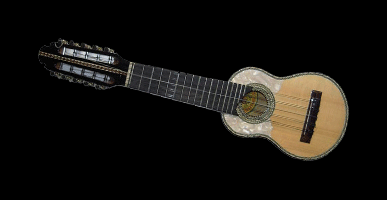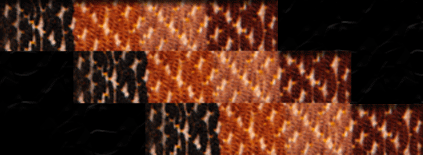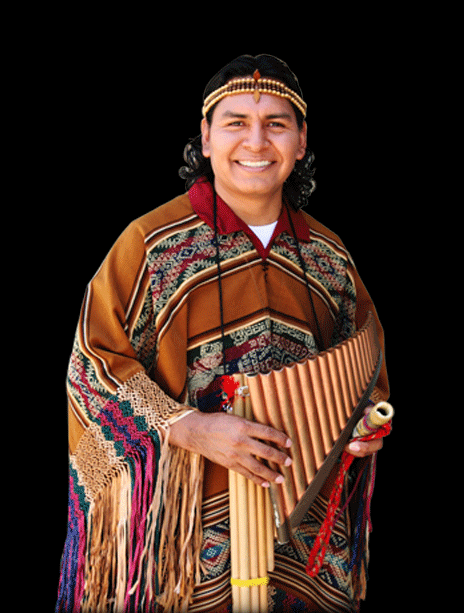![]()
![]()
GLOSSARY
IN THIS GLOSSARY YOU CAN FIND THE MEANING OF THE NEAREST VOCABULARY RELATED TO RENE AND HIS CULTURE
GET TO KNOW AND SHARE.
QUECHUA:
“Quechua or Quichua is a Native South American language family and dialect cluster spoken primarily in 7 countries of the Andes of South America.
In the century XV it began the official language to the Inca State. At the beginning of the XX century, Quechua, was set back by the advance of Spanish through schooling in rural areas.
Nowadays, Quechua is the most widely spoken language family of the indigenous peoples of the Americas, with a total of probably some 6 to 8 million speakers estimates vary widely in Bolivia, Perú and Ecuador.
The Quechua language family is characterized as binders, and has regular roots that bind to a large number of suffixes to form words with a high plasticity of meaning.

BAMBOO:
“Bambuseae is a tribe composed of native plant from Asia, America, Africa and Oceania that can be adapted to many climates (tropical, subtropical and temperate).
This plants are very old (Miocene), rustic and totally atypical. Bamboo has inspired mythology and symbolism.
It is extremely useful and has been described for more than 1,500 applications and utilities because of its high strength and flexibility is called "the steel plant.
Its genetic structure corresponds to the grass one and can grow up to 46.8 inches in 4 years (depending on species and stage) and to nearly 1 meter per day. This capacity for growth and renewal can make from the bamboo a very important resource for the low income areas."
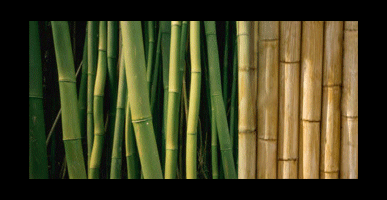
HUAYNO:
musical rhythm
“Huayno or huayño (Quechua: wayñu) is an important musical genre and Andean Inca dance with its very popular origin among the Andean countries that were part of Tawantinsuyu, mainly in Peru and Bolivia. Huayno takes various forms, according to local or regional traditions, and in some ways represents the popular adherence to the culture of the land. It is considered the Andean dance par excellence.
The man offers his right arm to invite to dance, or put a handkerchief on her shoulder, then made the walk of couples around the grounds, and finally the dance, which is a nimble footwork and vigorous during which beset man the woman, face to face. Their movements are lively and mischievous.
Its musical structure stems from a pentatonic basis of binary rhythm, structural feature that has allowed this genre to become the basis of a series of hybrid rhythms, from Kumbia to Andean rock. The instruments involved in the implementation of Huayno are the flute, Charango, mandolin, harp, fife, mandolin, guitar and violin.
In some variants of the typical bands involved Huayno, adding trumpets, saxophone and accordion.”
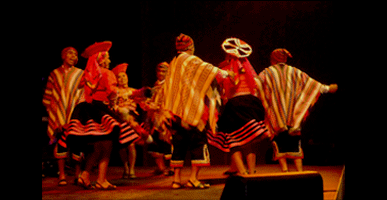
SAYA:
musical rhythm
“ The Saya is a Afro-Bolivian-Peruvian is a style of music and dance which is the product of the fusion of African, Aymara and Spanish elements.
The accompaniment of drums and guanchas between soloist and choir songs come from the African roots, while the dress adopted from women comes from the Aymara women dressing.
Until the time of the agrarian reform Saya was a dancing for "festivities only with prior approval of the employer". In 1970, the creators of the dance “Caporales” were inspired precisely by a presentation from an African group of Tocaña relegated for many years. From the years 1980, Saya became from a village dance, typical of a black minority based in the Yungas, to a social movement that has enormously increased the confidence of Afro-Bolivians.
Inquiries were made about how they were the music, dress and dance and these characteristics are well defined: The men sing, with their powerful voices, repeated verses that women with their beautiful voices of sopranos repeat or answer to them. The dance movements are very rhythmic and sensual and mark the beat of the drums and watered-regues that men play.
The Saya is a mixture of feelings, which can be joy and sadness, among others."
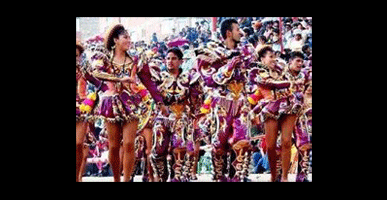
TINKUS:
musical rhythm
“It has been accepted as a cultural dance in the whole nation of Bolivia. Tinku music has a loud constant drum beat to give it a native warlike feel, while Charangos, guitars, and Zampoñas (panpipes) play melodies. The dancers perform with combat like movements, following the heavy beat of the drum.
For men, the costumes are more colorful. Their monteras are usually decorated with long colorful feathers. Tinku Suits, or the outfits men wear during Festive Tinku performances, are usually made with bold colors to symbolize power and strength.
Women wear long embroidered skirts and colorful tops. Their costumes are completed by extravagant hats, painted and decorated with various long and colorful feathers and ribbons. Men and women wear walking sandals so they can move and jump easily.”

MORENADA:
musical rhythm
“The Morenada is a music and dance style from the Bolivian and Peruvian Andes characterized by a mixture of African and native elements. The origins of this dance are debated among specialists on this topic, the three main hypotheses say that the dance could have been inspired in African slaves brought to Bolivia to work in the silver mines of Potosí, another theory states that it would be inspired in the Afro-Bolivian community living in the Yungas region of La Paz, and the third main theory links this dance with the Aymara culture due to the findings of cave paintings in the Lake Titicaca shores in the Taraco peninsula.
This dance takes great strength in the Carnival of Oruro, the second most famous carnival in Latin America, declared by UNESCO a Masterpiece of the Oral and Intangible Heritage of Humanity "and in the Department of La Paz in the Fiesta del Gran Poder.”
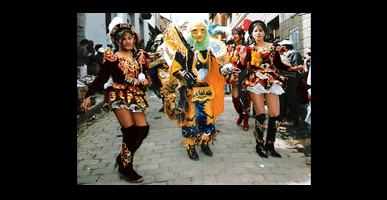
CARNAVALITO:
musical rhythm
“The Carnavalito (English: Little Carnival) is a traditional South American dance from the Altiplano and Puna regions that is practiced in relation to religious festivities. The current form of the dance is an expression of syncretism between indigenous and Spanish colonial culture.
The Carnavalito was danced in the Americas long before the Spanish arrived. Today it is still danced in Perú, in the eastern region of Bolivia, in the northwest zone of Argentina and in Northern Chile. In Argentina it is danced in the north of Jujuy and in center Salta.
The music is characterized by the use of instruments such as the Quena and the Bombo; its origin comes from the Huayno, music similar to the Carnavalito.”
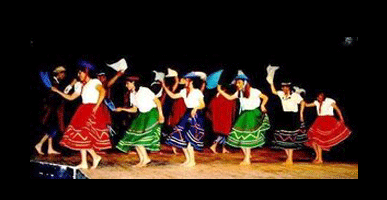
CUMBIA:
musical rhythm
“Cumbia is a rhythm and a folk dance native from the Caribbean coast of Colombia and also a variations in character and traditional folk in Panama.
Arises from the musical and cultural syncretism of indigenous, black and Europeans in the region of Magdalena River delta in the Colombian Caribbean coast.
The truest form of cumbia is purely instrumental, the beat is 2/4 and is traditionally performed and followed by the drum set: caller, cheerful, drum and flute or bagpipes or male and female gaitas, the maracas and gouache.”
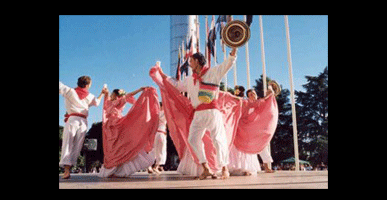
CUMBIA ANDINA:
musical rhythm
“Chicha o Cumbia tropical Andean or Andean music is a subgenre of Peruvian Cumbia, resulting from the merger of (Cumbia) with Andean music (Huayno) and other tropical rhythms of Peru.
Born in Lima but initially is appreciated and is disclosed in the central region of the Peruvian Andes, specifically in the city of Huancayo in the decade of 1970, as a manifestation of migration from the Andean areas started in the 1950 to the city.
In the 1980, was consolidated in Peru as a musical style popular in many countries of the region such as Bolivia, Argentina and Chile.”
CHUNTUNKI:
musical rhythm
“Chuntunqui is the traditional Christmas music in the department of Chuquisaca in Bolivia. Generations have danced to the Christmas Nativity, getting connecting in time with those Christmas musical that came from old Europe in the sixteenth century on the hand of Franciscans and Jesuits.
During the colonial period Sucre city name "La Plata" on those days; concentrated aristocratic social classes with the habit of dancing to Christmas Nativity. Black slaves of that time danced this rhytm with acrobatic pantomime moveements. This rhytm start to be known as chuntunquis by the indigenous features which means black dance."
TOBAS:
musical rhythm
"The Toba dance was inspired by a ethnic group from the south of the bolivian territory in the vicinity of the Pilcomayo River; located in the area near by to the Tupi-Guarani, matacos, Tapiete and others cities located in the Gran Chaco Boliviano(in the big cities of Tarija Santa Cruz). The Toba dance expressed through the elastic movements and the warrior attitude based on their beliefs and represented in rites of veneration to little gods from nature."
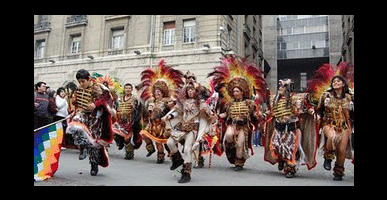
QUENA:
Musical Instruments - Winds
“The quena is an Andean instrument of pre-millenerian origin. Thanks to its musical flexibility of being so adaptable and tunable in so great a variety of ways, it can be made of wood or bamboo, though its ancestors were also made of clay, stone and bone, especially the wing bones of the condor.
The quena is a vertical flute, tubular in shape, open at both ends, with a U-shaped mouthpiece that is placed at the tip of the lower lip when blowing air to produce sound. It has six finger-holes in front and one in the back.
Quenas are available in a variety of sizes, according to purpose and to local customs. Not surprisingly, different groups of Andean natives use their own tuning for this instrument, which may vary in shape, size and even in name, from place to place. The modern standard professional quena is tuned to G major.
In additional Quenas vary in size for example “The quenacho” is a larger quena.”
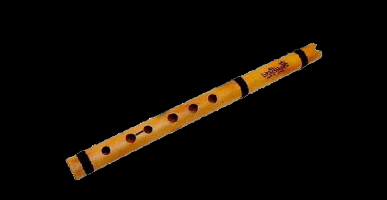
ZAMPOÑA:
Musical Instruments - Winds
“Not to be mistaken for the European panflute, the siku (in Quechua and Aymara) or zampoña (in Spanish), is a cane panpipe native to the highlands surrounding lake Titicaca, between Perú and Bolivia.
The siku has two separate rows of pipes open at one end and closed at the other, with each row containing every other note of the musical scale. Usually, there is a row of six pipes, called the ira, and one of seven, known as the arca. The pipes are held in place by two or more straps, also made of cane, running across the width of the instrument, and by threads or cloth braided between the pipes and attached to the straps. Present-day sikus are made from highland bamboo and from chuqui, a cane found in the outskirts of many Peruvian forests. In Bolivia, a cane called zongo is also used. In ancient times, sikus were also made of clay or stone.
Depending on size, sikus are known by different names, which may vary from place to place. The malta (about 11.5 inches long). The chuli, or chili, is an octave higher and about 5.5 inches in length. The sanka or basto (about 23 inches) is twice the size of the malta and an octave lower. Further down the tonal scale, we find the toyo (about 46.5 inches), twice the size of the sanka and an octave lower still.
From times immemorial, Andean man has used the siku to express his character, feelings, sentiments and emotions. His happiness, grief, pride and feats as a warrior have found their deepest expression thus. Since long before the Inkas, the siku has been an instrument both ritual and magical through which the many Andean cultures have expressed their deepest spiritual tradition.”
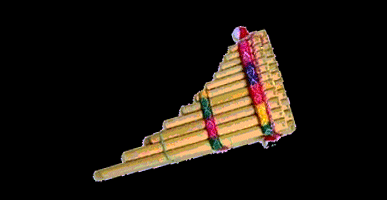
ANTARA:
Musical Instruments - Winds
“The pre-Inka Nazca culture developed its musical language and spiritual expression through the antara. Although present-day antaras are made of bamboo, in times past they were made of several types of clay-like muds, fired to achieve hardness, with some instruments taking on a terra-cotta appearance.
The antara is made from a single row of cylindrical pipes arranged by size to give the instrument an essentially triangular shape. The number of pipes in each of these instruments varies from three to fourteen.
Antaras found in Inka burial sites are mainly pentatonic and are made of cane fastened by multicolored threads of cotton or wool. These instruments vary substantially from their Nazca counterparts, not only in the method of construction, but also in their musical quality.
In truth, the original Nazca antara is a musical enigma: Thanks to it diatonic and chromatic scales, it offers major musical possibilities than those of the Inka instruments that appeared subsequently.”
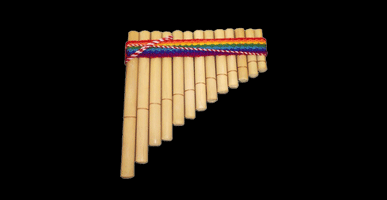
RONDADOR:
Musical Instruments - Winds
“The rondador, the national musical instrument of Ecuador, is similar in construction to the zampoña or siku. This instrument has a single row of pipes arranged pentatonically, interlaced from major to minor: Each note is followed by its lower third, making it possible to play a melody in parallel thirds. To this end, the player must blow air in two adjacent pipes simultaneously.
This instrument is the most typical and representative of the Andean people of Ecuador and parts of Northen Perú. San Juanito is the most well known rhythm associated with this instrument.
Today, the rondador is available in a variety of tunings. For its construction, the thinnest bamboo canes are selected to produce instruments with a soft sound. At the time of the Inkas, feathers from the wing of the condor were also used to give such instruments a magical aura and a ritualistic character.”

OCARINA:
Musical Instruments - Winds
“The ocarina is yet another Andean wind instrument of pre-millenerian origin. Its sound is melancholic and might even be described as painful. Since times lost to human memory, ocarinas have been made of a number of materials: a variety of fired clay-like muds, stone, wood and large seeds. In addition to being used for musical tuning, ocarinas were made to imitate animal sounds, especially bird voices.
The ocarina is a globular flute, with or without a mouthpiece (to channel air inflow), such that sound is extremely easy to produce. In the Andean world, this instrument can be found in many varieties and with a multitude of decorations. Some have eight finger-holes in the upper part (four for the fingers of each hand) and two in the lower part (one for each thumb).
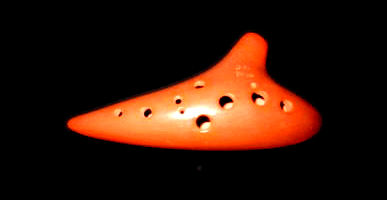
RAIN STICK:
Musical Instruments - Percussion
“The palo de lluvia (rainstick), or palo de agua (waterstick), is a musical and ceremonial instrument used in many communities from ancestral times to the present. Its name is descriptive of the sound of falling rain the instrument produces. Rainsticks are made only from dead cacti, found predominantly in the desert zones of Northern Chile. The thorns of the cactus branch are pressed into the hollow shaft to form a spiral pattern. Filled with desert pebbles, the rainstick produces its characteristic sound when it is tilted to allow the pebbles to run through its interior.
The origin of the rainstick is a mystery. According to legend, its sound has the spiritual power to serenade the rain gods. Indeed, some maintain that the Diaguita People of the Elqui Valley in Northen Chile use the rainstick to this day in ceremonies to invoke the rain spirits.
In modern society, the rainstick, in addition to being widely used as a musical instrument, is also used by persons of all ages as a toy or as a tool for relaxation.”
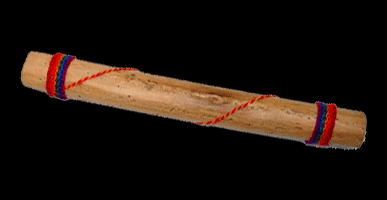
WANKARA:
Musical Instruments - Percussion
“The wankara is a large, round drum with goat skin stretched across both ends. It has a deep, bass sound. It most commonly played in sikureadas, a musical performance where a large group plays zampoñas or sikus and drums.”
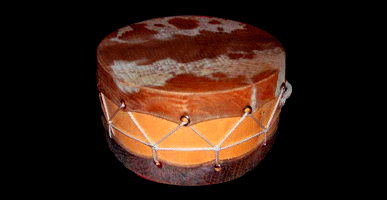
BOMBO:
Musical Instruments - Percussion
“The bombo is a percussion musical instrument membranophone, consisting of a cylinder, usually of wood, at the ends fit a stretched membrane that can usually be leather of rabbit, which is beaten with rods or sticks to produce sounds. The hype is widely used in the battery of percussion that often accompanies modern rock and pop, as well as the bands.
Its sides are made of thin sheets of wood, while at the ends has a piece of leather tightly stretched to achieve the vibration of sound to be beaten by a stick of wood. To prevent that the leather is sturdy and does not dry out, the master musicians at the time to create the instrument, smear grease on the inner parts of the material.
The bombo is an instrument purely rhythmic that beats time and times in the melodies and is an essential tool in the interpretation of Bolivian folk music, as in Latin American folk music in general. "
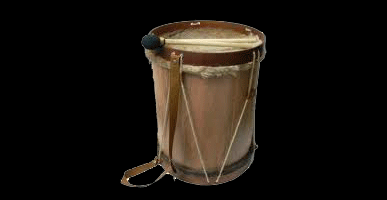
CHAJCHAS:
Musical Instruments - Percussion
“The chajchas (chullus in Bolivia) is a ribbon to which there are tied several goat, sheep, llama or alpaca. When shaken, the sound produced suggests that of wind and falling rain.”

CHARANGO:
Musical Instruments - Percussion
“The charango is the only stringed instrument native of the Andes. Fashioned after the Spanish guitar, the charango appeared in the 18th century between Bolivia and Perú. Made of armadillo shell or wood, this instrument has ten strings. It is rather small in size so that shepherds may carry it easily while herding their lamas.
Usually the charango has five double orders, or five pairs of strings but in Ayacucho-Peru is usually simple, two at each end, and a double that is the middle. The carved or lacquered box are more common in the area of Bolivia and in Peru are commonly laminated.
In Bolivia, since the sixties, have become popular mainly in three sizes: The Walaycho (50 cm), the Charango (60 cm) and The Ronroco (75 cm). Other sizes are given as regional variations, or because of certain performers acoustic experiments.“
